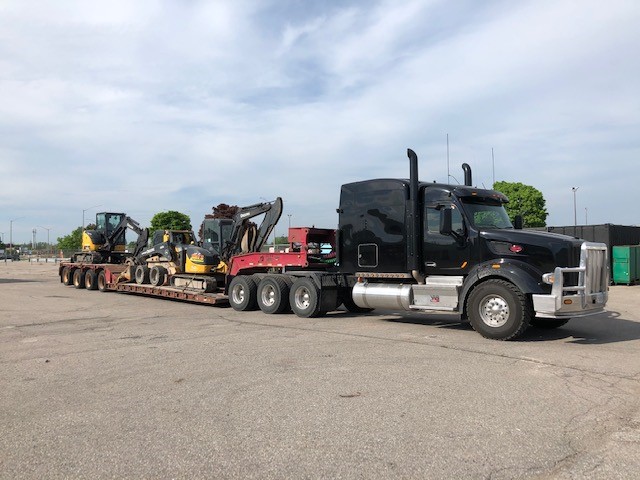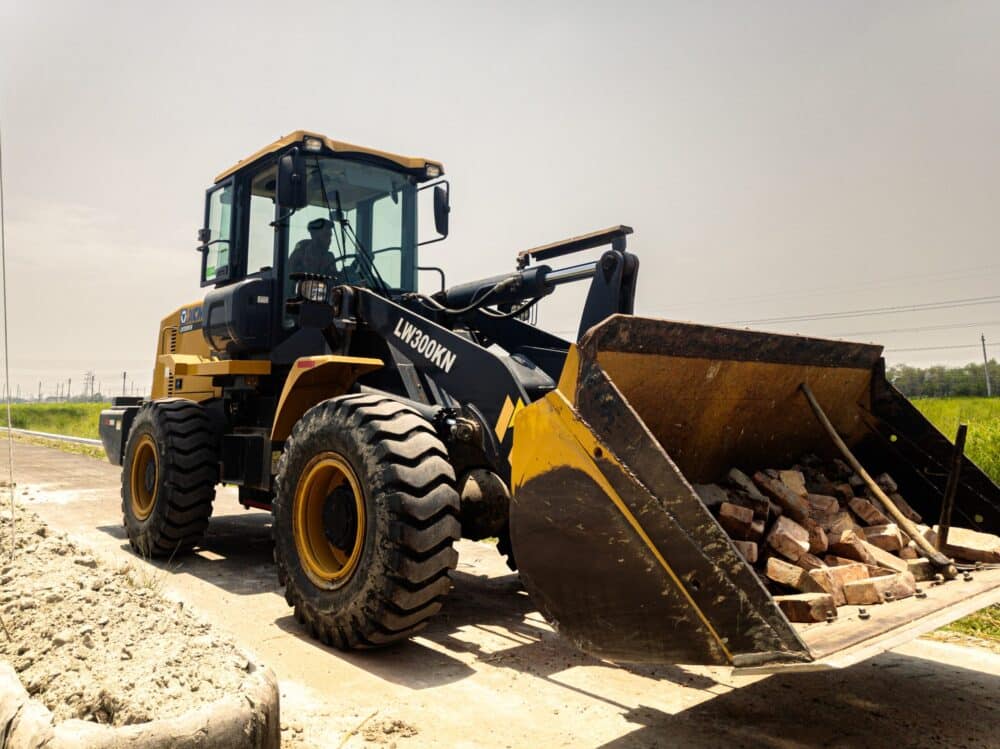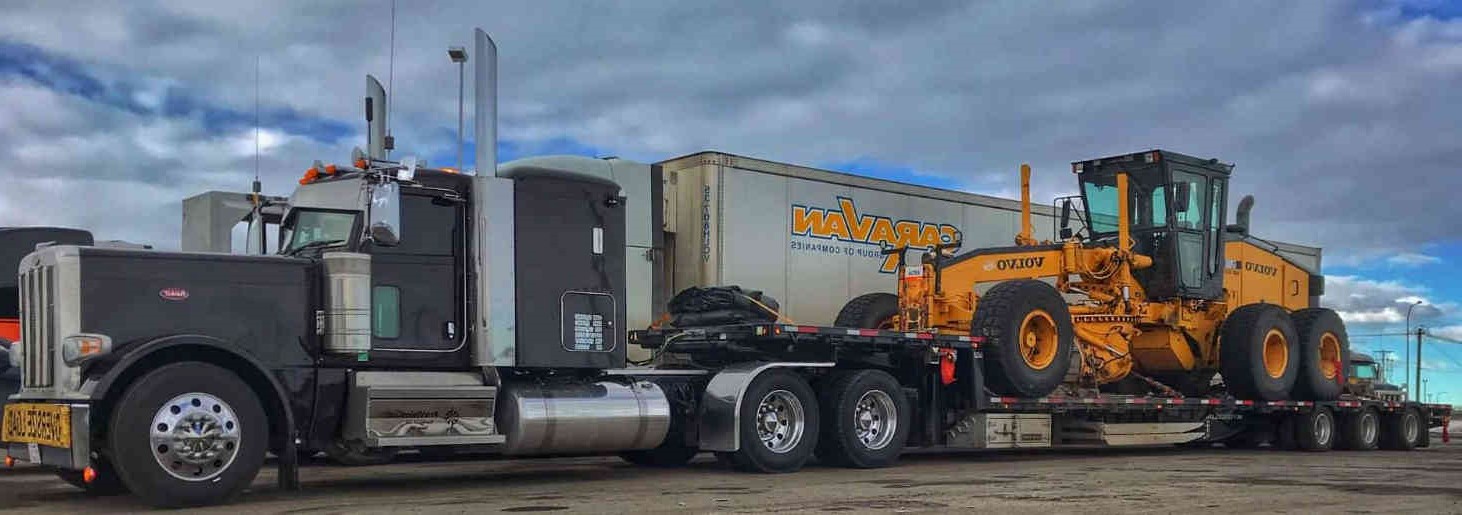Excavators are very large pieces of heavy machinery. When you purchase an excavator from an auction or need to transport your equipment from one job site to the next, you can use the services of a heavy hauler. Heavy haul drivers have the skills, expertise, and equipment to move an excavator safely. Depending on the size of your excavator, the shipping regulations will vary. Provincial permits and pilot cars may be required, so planning is essential.
1. Know the Dimensions: How Big Is Your Excavator?
The cost of shipping, the type of trailer, the securement procedure, and the need for permits all depend on the size of your machine. For oversized equipment hauling, you may require escort vehicles or pilot cars for safety during your transport route, to avoid mistakes like this Calgary incident.
Types of Excavator
Crawler Excavators
Hydraulically powered crawler excavators run on tracks instead of wheels. This makes them ideal for use on uneven terrain for mining, landscape grading, and trench digging.
Wheeled Excavators
Wheeled excavators are used on flat and hard surfaces. You will commonly find these types of heavy equipment on highway projects.
Long Reach Excavators
Long-reach excavators feature a lengthier arm and boom section. These excavators are used in demolition projects where the operator needs to be a safe distance away from the construction zone.
Mini Excavators
Mini excavators are used on delicate surfaces or in tight spaces. They are ideal for residential landscaping, digging trenches, and construction sites where space is limited.
Get Your Excavator Specs
If you are not sure of the specs of your machine, use our powerful Specs Tool. Our database contains over 60,000 pieces of heavy machinery across several industries. Just enter the make and model to get the weight and dimensions of your machine.
2. Choose the Right Trailer For Your Excavator
When preparing your heavy equipment for transport, it is important to choose an appropriate trailer to accommodate the size and weight of your machine.
Mini excavators weighing less than 6 tons and midi excavators that range from 6 – 10 tons can usually be transported on a smaller trailer designed to hold weights of up to 10,000 lbs. Due to their smaller size, they don’t usually require any permits or special procedures for transport.
Standard excavators weigh anywhere from 10 to 90 tons. The heavier machines often require a removable gooseneck trailer with additional axles to support the weight. These machines are often used with multiple attachments, which is an important consideration for transport.
Transporting Excavator Attachments
A smaller boom and bucket can remain attached to the machine on the trailer. However, you may need a larger trailer or a separate truck and trailer to carry additional parts of the excavator, such as a hydraulic hammer or a root rake. When you book a heavy haul driver, it is essential to let them know about any extra attachments you need to have transported. Provide the specs of these items and upload photos to assist with the delivery.
3. Find An Experienced Heavy Haul Driver
When you want to connect with a driver, it is important to consider their skills and experience. Shipping heavy machinery is complex and requires a driver with the knowledge of how to handle and transport your equipment safely.
Ensure Your Driver Is Cargo Insured
Heavy equipment is expensive, which is why it’s also essential to hire a driver who has adequate cargo insurance to protect your machinery during transit. Although it’s not common, accidents can happen, and a lack of insurance may leave your valuable equipment unprotected.
Connect With a Heavy Haul Driver
To connect with a heavy haul driver, start by getting a quote on your delivery using our instant, free shipping calculator.
- Enter the pick-up location for your machine
- Enter the drop-off destination
- Enter the weight and dimensions of your excavator
Once you get your free quote, post it to the Trusted Dispatch load board to connect with a driver within 24 to 48 hours.
4. Prepare Your Excavator for Transport
Get your machine ready for transportation ahead of the pick-up date so your driver can load it without delay.
Clean Your Machine
Wash down the equipment to remove any dirt or debris caked onto the surface. The wheel areas are an important region to clean along with the tie-down points so the driver can easily secure the excavator to the trailer. This will also expose any damage to your machine before pick up so you can assess for any problems during transit. With a clean machine, you can also take pictures to provide proof of condition when selling your machine or to showcase the equipment to your driver ahead of time.
Empty The Cab
If you are moving your machine from one job site to the next, remove any personal belongings that may be sitting in the cab. Not only will you need your belongings, but it also prevents any damage potentially caused by objects flying around inside the cab during transit.
5. Stay in Touch During Transport
Once you have booked your transportation, you will receive the contact information for your driver. Make sure to discuss the job and any special requirements ahead of time so that they can better prepare. Connect before the scheduled pick-up to ensure everything is on track and your driver will arrive as expected. Stay connected with your driver during transport to assess for any delays caused by inclement weather or traffic congestion.
Your Trusted Load Board for Heavy Equipment Shipping
Whether you need to transport a compact excavator or a large hydraulic excavator, our heavy haul drivers will transport your equipment safely to its destination. Get started by getting your instant free quote today.




